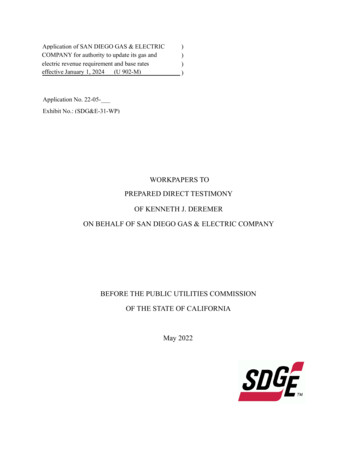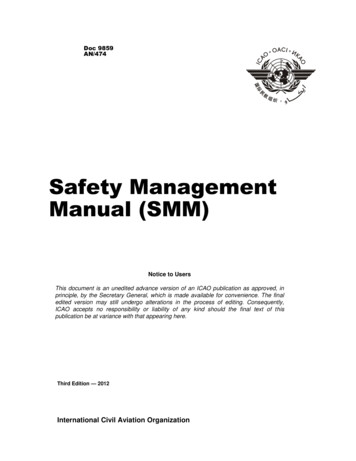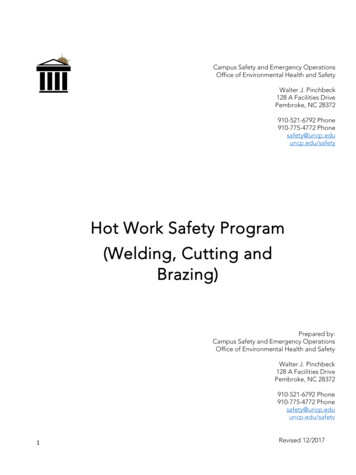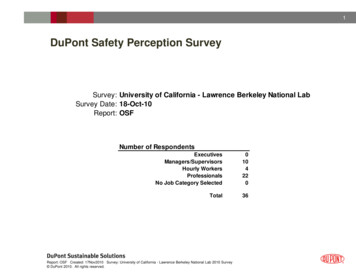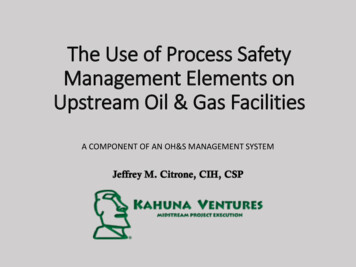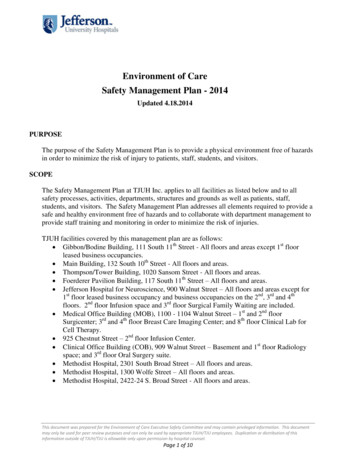
Transcription
Environment of CareSafety Management Plan - 2014Updated 4.18.2014PURPOSEThe purpose of the Safety Management Plan is to provide a physical environment free of hazardsin order to minimize the risk of injury to patients, staff, students, and visitors.SCOPEThe Safety Management Plan at TJUH Inc. applies to all facilities as listed below and to allsafety processes, activities, departments, structures and grounds as well as patients, staff,students, and visitors. The Safety Management Plan addresses all elements required to provide asafe and healthy environment free of hazards and to collaborate with department management toprovide staff training and monitoring in order to minimize the risk of injuries.TJUH facilities covered by this management plan are as follows: Gibbon/Bodine Building, 111 South 11th Street - All floors and areas except 1st floorleased business occupancies. Main Building, 132 South 10th Street - All floors and areas. Thompson/Tower Building, 1020 Sansom Street - All floors and areas. Foerderer Pavilion Building, 117 South 11th Street – All floors and areas. Jefferson Hospital for Neuroscience, 900 Walnut Street – All floors and areas except for1st floor leased business occupancy and business occupancies on the 2nd, 3rd and 4thfloors. 2nd floor Infusion space and 3rd floor Surgical Family Waiting are included. Medical Office Building (MOB), 1100 - 1104 Walnut Street – 1st and 2nd floorSurgicenter; 3rd and 4th floor Breast Care Imaging Center; and 8th floor Clinical Lab forCell Therapy. 925 Chestnut Street – 2nd floor Infusion Center. Clinical Office Building (COB), 909 Walnut Street – Basement and 1st floor Radiologyspace; and 3rd floor Oral Surgery suite. Methodist Hospital, 2301 South Broad Street – All floors and areas. Methodist Hospital, 1300 Wolfe Street – All floors and areas. Methodist Hospital, 2422-24 S. Broad Street - All floors and areas.This document was prepared for the Environment of Care Executive Safety Committee and may contain privileged information. This documentmay only be used for peer review purposes and can only be used by appropriate TJUH/TJU employees. Duplication or distribution of thisinformation outside of TJUH/TJU is allowable only upon permission by hospital counsel.Page 1 of 10
Environment of Care Safety Management Plan - 2014OBJECTIVESThe objectives of the Safety Management Plan include: Comply with all relevant safety standards and regulations. Enforce current safety practices for patients, staff, students, and visitors. Provide regular safety education to all staff. Monitor the effectiveness of the safety program. Identify opportunities and to improve safety performance and develop and implementimprovements.AUTHORITYThe Chair of the Safety Management Subcommittee is responsible for the program’s strategicdesign and overall plan development, implementation, monitoring, and performanceimprovement. The Directors of EHS at the respective Center City and Methodist campuses areresponsible at an operational level for enforcing all safety practices, monitoring, and reporting.Performance reporting for the program is monitored by the Environment of Care Committee.RISK ASSESSMENTHazardous physical conditions, potentially hazardous situations, unsafe behaviors, and relativerisks are identified and assessed through ongoing facility-wide processes. These processes aredesigned to proactively evaluate the impact of building, grounds, equipment, materials,operations, and internal physical systems on patient, staff, student, and public safety. The SafetySubcommittee works with the Environment of Care Committee and the Hospital RiskManagement department to identify, analyze, and control environmental risks to patient, staff,student, and visitor safety that may contribute to undesirable outcomes. These assessmentprocesses include: Annual subcommittee multi-disciplinary Risk Assessment Environmental Safety Tours Work-related injury assessments Patient Safety Net (PSN) SAFE Line (955-SAFE; 5-7233)PERFORMANCE ELEMENTS:Standard EC.01.01.01 – The hospital plans activities to minimize risks in the environmentof care.EC.01.01.01 (1)(Leaders identify an individual(s) to manage risk, coordinate risk reduction activities in thephysical environment, collect deficiency information, and disseminate summaries of actions andresults.The President appoints Safety Officers responsible for developing, implementing,monitoring, administering and directing an ongoing, organization-wide process to collectThis document was prepared for the Environment of Care Executive Safety Committee and may contain privileged information. This documentmay only be used for peer review purposes and can only be used by appropriate TJUH/TJU employees. Duplication or distribution of thisinformation outside of TJUH/TJU is allowable only upon permission by hospital counsel.Page 2 of 10
Environment of Care Safety Management Plan - 2014information about opportunities for improvement in the TJUH, Inc. Safety Managementprogram. The Safety Officer has the authority and duty to take immediate andappropriate action in the event that a hazardous condition exists, which poses a threat tolife, personal injury /illness, or the threat of damage to property.The Board of Trustees receives annual reports of the activities of the Safety ManagementProgram from the EOC Committee. The Board of Trustees reviews reports and asappropriate communicates concerns about identified issues and regulatory compliance.The Board of Trustees provides support to facilitate the ongoing activities of the SafetyProgram.EC.01.01.01 (2)Leaders identify an individual(s), to intervene whenever environmental conditions immediatelythreaten life or health or threaten damage to equipment or buildings.Safety Officers have the delegated the authority to take action when hazardous conditionsor potential hazardous conditions exist.Standard EC.02.01.01 – The hospital manages safety and security risks.EC.02.01.01 (1)The hospital identifies safety and security risks associated with the environment of care thatcould affect the safety and health of patients, staff and other people coming to the hospital’sfacilities.The risk assessment process is designed to proactively evaluate the impact on patient careas it relates to the safety of the buildings, grounds, internal physical systems, and the safepractices of hospital employees.EC.02.01.01 (3)The hospital takes action to minimize or eliminate identified safety and security risks in thephysical environment.TJUH, Inc. uses the risks identified to select and implement procedures and controls toachieve the lowest feasible potential for adverse impact for the safety and health ofpatients, staff, students, and visitors.EC.02.01.01 (5)The hospital maintains all grounds and equipment.The Directors of Facilities Services are responsible for supervising the activities of thegrounds maintenance crew. The grounds maintenance crew will maintain the propertyaccording to the expectations of the hospital. Monitoring of equipment and preventativemaintenance and inspection procedures, as well as education and training of users toprotect against failure or user error are monitored and maintained by the Directors ofFacilities Services.This document was prepared for the Environment of Care Executive Safety Committee and may contain privileged information. This documentmay only be used for peer review purposes and can only be used by appropriate TJUH/TJU employees. Duplication or distribution of thisinformation outside of TJUH/TJU is allowable only upon permission by hospital counsel.Page 3 of 10
Environment of Care Safety Management Plan - 2014EC.02.01.01 (11)The hospital responds to product notices and safety recalls.The Department of Supply Chain Management coordinates with and ensures effectivefollow up from responsible parties for product safety alerts, hazard notices, and recalls.Facilities Operations Directors assess risk and develop appropriate responses forfacilities-related issues. The Department of Biomedical Instrumentation reviews theclinical equipment inventory to screen for equipment matches and will evaluate theseverity of the risk. In many cases, the notices will be addressed without removingequipment from service. In the event equipment must be removed from service, theequipment is replaced with a safe effective substitute. The Department of BiomedicalInstrumentation will impound equipment removed from use due to recall notices until itcan be rendered safe.Standard EC.02.01.03 – The hospital prohibits smoking except in specific circumstances.EC.02.01.03 (1)The hospital develops a written policy to prohibit smoking in all buildings. Exception forpatients in specified circumstances is defined.TJUH Inc. has developed a policy that prohibits smoking by staff, inpatients, outpatients,visitors, vendors, contractors, and others in all Thomas Jefferson University Hospitals,Inc. buildings and designated outdoor areas.EC.02.01.03 (4)If the hospital decides that patients may smoke in specific circumstances, it designates smokingareas that are physically separate from care, treatment and services areas if patients are allowedto smoke.TJUH Inc. does not permit patient smoking. Patients who are in the need for suchtherapy, through physician orders, will receive alternative treatment.EC.02.01.03 (6)The hospital takes action to maintain compliance with its smoking policy.Security rounds are conducted and the rounds checklist includes identifying any smokingin the facility.Standard EC.02.06.01 – The hospital establishes and maintains a safe, functionalenvironment.EC.02.06.01 (1)Interior spaces meet the needs of the patient population and are safe and suitable to the care,treatment, and services provided.EC.02.06.01 (11)Lighting is suitable for care, treatment, and services.EC.02.06.01 (23)The hospital provides emergency access to all locked and occupied spaces.EC.02.06.01 (20)Areas used by patients are clean and free of offensive odors.This document was prepared for the Environment of Care Executive Safety Committee and may contain privileged information. This documentmay only be used for peer review purposes and can only be used by appropriate TJUH/TJU employees. Duplication or distribution of thisinformation outside of TJUH/TJU is allowable only upon permission by hospital counsel.Page 4 of 10
Environment of Care Safety Management Plan - 2014EC.02.06.01 (26)The hospital keeps furnishings and equipment safe and in good repair.Facilities Design and Construction designs and constructs spaces in accordance withcurrent FGI Guidelines. Design parameters are reviewed with clinicians, FacilitiesOperations staff, Infection Control, and Environmental Health and Safety during designas necessary and are reviewed as a part of the Preconstruction Risk Assessment process.As a part of environmental safety tours, Environmental Health and Safety surveys interiorspaces, observing whether: Spaces are sufficient to meet the needs of the patientpopulation and are safe and suitable; lighting is suitable; and spaces are clean and free ofoffensive odors. Any deficiencies are reported to appropriate staff for follow up andcorrection per EC.04.01.01 EP’s 12 and 13 as noted below. Security, FacilitiesOperations Staff, and Department Managers provide emergency access to all locked andoccupied spaces.Standard EC.02.06.05 – The hospital manages its environment during demolition,renovation, or new construction to reduce risk to those in the organization.EC.02.06.05 (1)When planning for new, altered, renovated space, the hospital uses the Guidelines for Design andConstruction of Health Care Facilities, 2010 edition.The PA Department of Health requires use of the 2010 edition of the FGI Guidelines.Facilities Design and Construction is responsible for managing project design, approval,and construction and ensures that the FGI Guidelines are used in the design andconstruction of hospital facilities.EC.02.06.05 (2)When planning for demolition, construction, or renovation, the hospital conducts apreconstruction risk assessment for air quality requirements, infection control, utilityrequirements, noise, vibration, and other hazards that affect care, treatment, and services.Facilities Design and Construction manages a preconstruction risk assessment for everydemolition, construction, or renovation project. The risk assessment considers airquality, infection control, utility requirements (including shutdowns), noise, vibration,and other hazards that may affect care, treatment, and services. The risk assessment isconducted with a multi-disciplinary team and the results are recorded on a form.EC.02.06.05 (3)The hospital takes action based on its assessment to minimize risks during demoltion,construction, or renovation.Facilities Design and Construction manages construction activities in such a manner thatthe results of the preconstruction risk assessment are conveyed to the project team forimplementation of established measures to mitigate risk. Permit forms identifying risksand measures are reviewed with contractors and maintained for all projects. Measuresare monitored through contractor daily checklists and through weekly project managerobservation reports.This document was prepared for the Environment of Care Executive Safety Committee and may contain privileged information. This documentmay only be used for peer review purposes and can only be used by appropriate TJUH/TJU employees. Duplication or distribution of thisinformation outside of TJUH/TJU is allowable only upon permission by hospital counsel.Page 5 of 10
Environment of Care Safety Management Plan - 2014Standard EC.04.01.01 – The hospital collects information to monitor conditions in theenvironment.EC.04.01.01 (1)The hospital establishes processes for continually monitoring, internally reporting, andinvestigating the following: Injuries to patients or others with the hospital’s facilities Occupational illnesses and staff injuriesBased on its processes, the hospital reports and investigates the following:EC.04.01.01 (3)Injuries to patients or others in the hospital’s facilities.Injuries to patients or others with the hospital’s facilities are continuously monitored byEnvironmental Health and Safety through accident and injury reports. Each incident isinvestigated to determine circumstances and causes and is reported. Significant issuesare reported at least quarterly to the Environment of Care Executive Safety Committee.EC.04.01.01 (4)Occupational illnesses and staff injuries.Occupational illnesses and staff injuries are continuously monitored by EnvironmentalHealth and Safety through injury and incident reports. Each incident is investigated todetermine circumstances and causes and is reported. Significant issues are reported atleast quarterly to the Environment of Care Executive Safety Committee.EC.04.01.01 (12)The hospital conducts environmental tours every six months in patient care areas to evaluate theeffectiveness of previously implemented activities intended to minimize or eliminateenvironment of care risks.Environmental tours are conducted semiannually in all patient care areas. Surveys areevaluated to determine if trends or patterns are present. A report identifying deficiencies,recommendations, actions taken, and resolutions of the deficiencies is kept on file in theDepartment of Environmental Health & Safety.EC.04.01.01 (13)The hospital conducts annual environmental tours in non patient care areas to evaluate theeffectiveness of previously implemented activities intended to minimize or eliminateenvironment of care risks.Environmental tours are conducted annually in all non-patient care areas of the hospital.All surveys are evaluated to determine if trends or patterns are present. A reportidentifying deficiencies, recommendations, actions taken, and resolutions of thedeficiencies is kept on file in the Department of Environmental Health & Safety.EC.04.01.01 (14)The hospital uses its tours to identify environmental deficiencies, hazards, and unsafe practices.Members of a multi-disciplinary Environmental Tour group conduct environmental toursto identify environmental issues, hazards and unsafe practices. Deficiencies are reportedThis document was prepared for the Environment of Care Executive Safety Committee and may contain privileged information. This documentmay only be used for peer review purposes and can only be used by appropriate TJUH/TJU employees. Duplication or distribution of thisinformation outside of TJUH/TJU is allowable only upon permission by hospital counsel.Page 6 of 10
Environment of Care Safety Management Plan - 2014to the department leader for correction and data is aggregated and reported back to theEnvironment of Care Committee.EC.04.01.01 (15)Every 12 months, the hospital evaluates each environment of care management plan, including areview of the plan’s objectives, scope, performance, and effectiveness.The annual evaluation of the Safety Management Plan includes a review of theobjectives, scope, performance and effectiveness. The evaluation provides the basis forperformance improvement and development of the plan for future risk assessments.Standard EC.04.01.03 – The hospital analyzes identified environment of care issues.EC.04.01.03 (1)Representatives from clinical, administrative, and support services participate in the analysis ofthe environment of care data.The Environment of Care Executive Safety Committee includes representatives fromclinical, administrative, and support services. The committee members activelyparticipate in the analysis of Environment of Care data, including quarterly reports fromeach of the Environment of Care Sub-committees – Safety, Security, HazardousMaterials and Waste, Fire Safety, Medical Equipment, and Utility Systems.EC.04.01.03 (2)The hospital uses the results of data analysis to identify opportunities to resolve environmentalsafety issues.Each of the Environment of Care Sub-committees, and the Environment of CareExecutive Safety Committee regularly, intentionally, and actively analyze data todetermine the effectiveness of processes and procedures, to identify trends and possiblecauses for safety issues, and to inform action plans developed to foster improvement insafety. As data is trended and reported to the committees, explanations are required fornegative trends and for measures that do not meet established goals. The analysis andexplanations are then reviewed and further discussed with the focus on improving safety.EC.04.01.03 (3)Annually, representatives from clinical, administrative, and support services recommend one ormore priorities for improving the environment of care.Each of the Environment of Care Sub-committees perform risk assessments and annualevaluations of their respective management plans, including plan performance andeffectiveness. Sub-committees are comprised of representatives from clinical,administrative, and support services. Safety issues with significant risk and opportunityfor improvement are identified to be monitored through performance measures. Subcommittee recommended performance measures are reviewed and monitored by theEnvironment of Care Executive Safety Committee.This document was prepared for the Environment of Care Executive Safety Committee and may contain privileged information. This documentmay only be used for peer review purposes and can only be used by appropriate TJUH/TJU employees. Duplication or distribution of thisinformation outside of TJUH/TJU is allowable only upon permission by hospital counsel.Page 7 of 10
Environment of Care Safety Management Plan - 2014Standard EC.04.01.05 – The hospital improves its environment of care.EC.04.01.05 (1)The hospital takes action on the identified opportunities to resolve environmental safety issues.Environmental safety issues are identified through monitoring and analysis of data andincidents. Those safety issues are discussed in Environment of Care Sub-committees andsignificant issues are discussed and tracked in the Environment of Care Executive SafetyCommittee. Action items are established for environmental safety issues, responsiblepersons are identified, and issues are tracked to completion and any required follow up.EC.04.01.05 (2)The hospital evaluates changes to determine if it resolved environmental safety issues.Environment of Care Executive Safety Committee and Sub-committee members operatewithin the rubric of the environment of care risk management cycle of Plan – Teach –Implement – Monitor – Respond – Improve. As such, further evaluation / monitoring ofissues is employed to continuously improve the particular environmental safety issue.Further data will typically be obtained and analyzed and additional responses developedto foster continued improvement.EC.04.01.05 (3)The hospital reports performance improvement results to those responsible for analyzingenvironment of care issues.Performance improvement results are reported and discussed at Environment of CareSub-committees and quarterly at Environment of Care Executive Safety Committeemeetings. The committee members analyze the results and recommend furtherimprovement where needed.ORIENTATION AND EDUCATIONOrientation and education for staff is managed and documented through Human Resources andindividual departments. This training includes, but is not limited to:A. New employee orientation - General Safety training regarding Bloodborne Pathogens,Hazard Communications, and General Safety are given to all new employees during NewEmployee Orientation. New employee orientation is delivered by a multi-disciplinary teamincluding staff from Environmental Health & Safety.B. Annual continuing education - Based on requirements of various healthcare regulatoryagencies and internally identified needs, a core curriculum of mandatory continuingeducation courses are established each year. Computer-based training is utilized as themethod to ensure compliance with annual mandatory safety training for all staff.C. Department-specific training - Department heads design educational programs for safety thatmeet their individual department needs. It is the responsibility of each department to:This document was prepared for the Environment of Care Executive Safety Committee and may contain privileged information. This documentmay only be used for peer review purposes and can only be used by appropriate TJUH/TJU employees. Duplication or distribution of thisinformation outside of TJUH/TJU is allowable only upon permission by hospital counsel.Page 8 of 10
Environment of Care Safety Management Plan - 20141. Ensure that each employee is assigned the correct safety curriculum for participationin the computer-based training program.2. If the department does not participate in the computer-based training program,designate an individual(s) to be the trainer/educator for the department with regard tosafety.3. Ensure that all employees within the department receive safety training.4. Reassess operations to ensure that any actual or potential safety and/or infectioncontrol hazards are identified and reported for inclusion in the educational program.D. Contract staff - Contract staff receive annual training on Jefferson Policies regarding safety.Jefferson’s Department of Environmental Health & Safety provides safety relatedinformation to contractors.PROGRAM EFFECTIVENESSProgram effectiveness will be regularly monitored using significant incidents as well as trendingof performance measures to indicate the effectiveness of the processes and/or systems in place.Performance monitoring and assessments of program effectiveness will be reported to the SafetySubcommittee. Significant events and outcomes of regular trending is reported by the SafetySubcommittee Chair to the Environment of Care Committee monthly meetings at least quarterlyor immediately as an exception for serious events.PERFORMANCE MONITORINGThe following safety performance measures are established for 2014:Recordable Workplace InjuriesRecordable workplace injuries will be monitored and reported monthly. Recordable workplaceinjury rates will be calculated and reported quarterly using the industry standard of annual injuryrate per 100 FTE’s (see calculation below). The numerator is the number or recordableworkplace injuries. The denominator is the total hours worked for the quarter divided by200,000. The quarterly rate goal is 6.0 recordable workplace injuries per 100 FTE’s. Resultswill be reported monthly to the Safety Subcommittee for review and Quarterly to theEnvironment of Care Committee.Overexertion Workplace InjuriesOverexertion workplace injuries will be monitored and reported monthly. Overexertionworkplace injuries will be calculated and reported quarterly using the industry standard of annualinjury rate per 100 FTE’s (see calculation below). The numerator is the number of reportedoverexertion workplace injuries. The denominator is the total hours worked for the quarterdivided by 200,000. The quarterly rate goal is 2.96 overexertion workplace injuries per 100FTE’s. This goal is based on the average rate of overexertion workplace injuries for 2013.Results will be reported monthly to the Safety Subcommittee for review and Quarterly to theEnvironment of Care Committee.This document was prepared for the Environment of Care Executive Safety Committee and may contain privileged information. This documentmay only be used for peer review purposes and can only be used by appropriate TJUH/TJU employees. Duplication or distribution of thisinformation outside of TJUH/TJU is allowable only upon permission by hospital counsel.Page 9 of 10
Environment of Care Safety Management Plan - 2014Needlestick Workplace InjuriesNeedlestick workplace injuries will be monitored and reported monthly. Needlestick workplaceinjuries will be calculated and reported quarterly using the industry standard of annual injury rateper 100 FTE’s (see calculation below). The numerator is the number of reported needlestickworkplace injuries. The denominator is the total hours worked for the quarter divided by200,000. The quarterly rate goal is 1.0 needlestick workplace injuries per 100 FTE’s. Resultswill be reported monthly to the Safety Subcommittee for review and Quarterly to theEnvironment of Care Committee.Workplace Injuries Rate CalculationCalculated annual injury rate per 100 FTE’s (Number of reported injuries x 200,000) / total hours workedANNUAL EVALUATIONThe annual evaluation of the Safety Management Program will include a review of the scopeaccording to the current Joint Commission standards to evaluate the degree in which the programmeets accreditation standards and the current risk assessment of the hospital. A comparison ofthe expectations and actual results of the program will be evaluated to determine if the goals andobjectives of the program were met. The overall performance of the program will be reviewedby evaluating the results of performance improvement outcomes. The overall effectiveness ofthe program will be evaluated by determining the degree that expectations were met. Theperformance and effectiveness of the Safety Management Plan will be reviewed by theEnvironment of Care Committee.Reviewed and submitted byJoseph ByhamSafety Subcommittee ChairDirector of Public SafetyThis document was prepared for the Environment of Care Executive Safety Committee and may contain privileged information. This documentmay only be used for peer review purposes and can only be used by appropriate TJUH/TJU employees. Duplication or distribution of thisinformation outside of TJUH/TJU is allowable only upon permission by hospital counsel.Page 10 of 10
Safety Management Plan - 2014 Updated 4.18.2014 PURPOSE The purpose of the Safety Management Plan is to provide a physical environment free of hazards in order to minimize the risk of injury to patients, staff, students, and visitors. SCOPE The Safety Management Plan at TJUH Inc. applies to all facilities as listed below and to all




